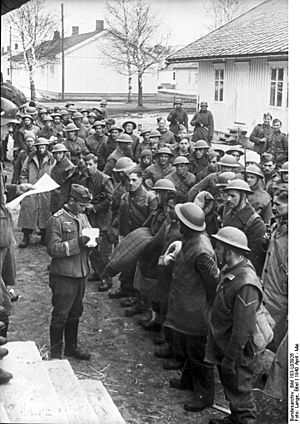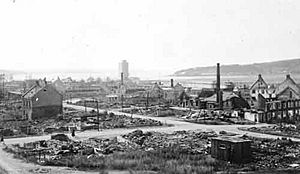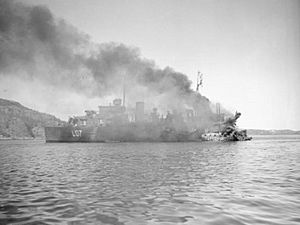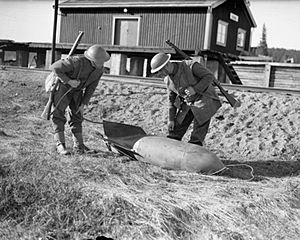Namsos campaign facts for kids
Quick facts for kids Namsos campaign |
|||||||
|---|---|---|---|---|---|---|---|
| Part of the Norwegian Campaign of the Second World War | |||||||
 British troops pick through the ruins of Namsos after a German air raid, April 1940. |
|||||||
|
|||||||
| Belligerents | |||||||
| Commanders and leaders | |||||||
| - | |||||||
| Strength | |||||||
| 3,500 British 2,500 French 500 Norwegians |
6,000 | ||||||
| Casualties and losses | |||||||
| British: 19 killed 42 wounded 96 missing |
? | ||||||
The Namsos campaign was a series of battles that took place in and around Namsos, Norway. This happened in April and early May of 1940, during the Second World War. It involved forces from Britain, France, and Norway fighting against German soldiers, ships, and planes.
This campaign was one of the first times that British and French land forces fought against the German Army during the war.
Contents
Why the Namsos Campaign Happened
Norway's Neutrality and German Attack
When the Second World War began in September 1939, Norway tried to stay neutral. They had done this successfully during the First World War. But in April 1940, Germany suddenly attacked Norway by sea, air, and land.
At that time, Norway's military was not fully ready. Their navy and coastal defenses had only small crews. The army had activated only a few groups of soldiers. Even though Norway had tried to update its military in the late 1930s, their armed forces were still quite weak.
Germany's Need for Iron Ore
Germany attacked Norway for several reasons. A big one was to get iron ore from mines in northern Sweden. This ore was vital for Germany's war factories to make tanks, guns, and other weapons.
In summer, the ore was shipped from a Swedish port called Luleå. But in winter, this port froze. So, for several months each year, most of the iron ore went by train through the ice-free port of Narvik in northern Norway. About 80% of the iron ore was exported through Narvik in winter. Without this Swedish steel from Narvik, Germany's war industry would have struggled.
British Plans and German Action
The British also had plans for Norway. They suspected Germany was using Norway's coastal waters to ship the ore. The British wanted to place mines in these waters to stop the German ships. Winston Churchill, a key British leader, was pushing these plans. However, Germany attacked Norway before the British could put their plans into action.
Allied Counter-Attack Plans
The Plan to Retake Trondheim
On the first day of the German attack, major Norwegian towns like Narvik, Trondheim, and Oslo were captured. British and French leaders quickly decided to take back Trondheim. They wanted to join up with Norwegian forces and stop the German advance north. This would help the Allies cut off Germany's iron ore supply. It would also give them air and naval bases in northern Norway.
Trondheim was important because Norway becomes narrow there. This would make it easier to block the Germans. If Germany wanted to get around this block, they would have to attack through Sweden, which might bring Sweden into the war on the Allied side.
Changes to the Plan
The original plan was to attack Trondheim directly by sea, using battleships to clear the way. Then, soldiers would land and capture the city. They also planned to land troops north and south of the city for a pincer attack (attacking from two sides).
However, the British military leaders changed their minds. They decided against the direct sea attack. Instead, they focused mainly on the pincer attacks from the north and south. This meant the British air force couldn't use the Trondheim airfields right away. It also meant the ground forces would face German ships in the fjord and German planes in the sky.
Namsos: A Key Landing Spot
Namsos, a town with about 3,600 people, was chosen as the best place to land the troops for the northern pincer attack. It had a good location and useful facilities. The harbour at Namsos is ice-free all year. It had three good wharves (docks) that were deep enough for smaller warships and transport ships. This made it perfect for landing troops and supplies needed to recapture Trondheim. Namsos also had a railway line and a gravel road leading south towards Trondheim.
Landing the Screening Force
On April 14, 1940, a small group of Royal Marines landed in Namsos. They were led by Captain Edds and set up positions in the hills outside the town. Soon, German planes spotted them.
The commander for the Allied forces, Lieutenant General Sir Adrian Carton De Wiart, arrived the next day. He got a taste of the danger when his plane was shot at by German aircraft as it landed. His helper was wounded and had to return to Britain. De Wiart was a brave and strong leader who inspired his soldiers, even during air attacks. However, there were no Allied planes over Namsos to protect them from the German air force (the Luftwaffe).
Because of the constant German air attacks, De Wiart decided it was too risky to bring large, slow troopships directly into Namsos. Instead, he sent them 100 miles north to Lillesjona. There, troops and supplies would be moved onto faster destroyers for a quick trip to Namsos. On April 16, De Wiart himself supervised this transfer. German bombers arrived, and the British naval commander ordered the destroyers to leave immediately with the troops they had on board.
Five destroyers, including HMS Afridi, sailed for Namsos. They carried De Wiart and over 1,200 soldiers. Despite repeated attacks during their journey, they arrived safely in Namsos around 9 pm on April 16.
Moving South from Namsos
General Carton De Wiart quickly managed the landing of troops and supplies. He made sure they got off the ships and into the hills during the few hours of darkness. Often, German planes didn't even know that landings had happened the night before.
De Wiart set up his headquarters in Namsos right away. He sent guards to the long bridge over Namsosfjord, which was important for one of the roads south. He also sent troops to occupy the village of Bangsund further south. Another 300 soldiers went east to Grong, where they met up with Norwegian troops. Smaller groups tried to reach Beitstadfjorden, closer to Trondheim.
De Wiart knew that the faster his forces moved south, the better their chances of taking Trondheim. His main goal was to reach Steinkjer, where the two roads south met, before the Germans arrived from Trondheim.
Meanwhile, the naval commander decided it was too dangerous to bring destroyers into Namsos. He sent troops and supplies on a Polish transport ship, MS Chrobry. This ship arrived in Namsos just before sunrise on April 17. In the rush to unload before German bombers arrived, many soldiers landed without much of their gear. Still, De Wiart managed to spread out the troops before German reconnaissance planes appeared.
At this time, Carton De Wiart did not know that the direct attack into Trondheimsfjord had been cancelled. He was often left unaware of what was happening elsewhere in Norway.
French Troops Arrive
On April 19, two groups of French Alpine troops landed in Namsos. They faced heavy air attacks. One of their transport ships was too big to enter the harbour. It had to return to the United Kingdom without unloading many French supplies. This left the French troops without important equipment like ski straps or the mules they used for transport. The French soldiers stayed in Namsos, suffering from air bombardments with little protection.
In total, about 6,000 Allied troops were landed. Most of the French troops were not used much in the short campaign because they lacked supplies. Towards the end, they did fight a bit as the Allied forces pulled back towards Namsos for evacuation.
Fighting in the South
By April 21, British forces had moved quickly south to the small village of Verdal. Here, both a road and railway bridge crossed the River Inna, a few miles from Trondheimsfjord. This was about halfway between Trondheim and Namsos. The British saw a German gunboat, two armed trawlers, and a destroyer in the fjord. These ships could land troops behind them and fire at them, and the British had no way to fight back.
When De Wiart landed in Namsos on April 15, the Germans had about 1,800 soldiers in the Trondheim area. They could fly in more troops daily using the Værnes airfield. By April 18, they had 3,500 men, and by the next day, 5,000. They were well-equipped, but lacked heavy artillery. Some German troops were sent to Hegra, where 251 Norwegians were holding out in an old fort. The Germans began moving up the fjord and reached Verdal on April 16.
The Verdal bridge was defended by about 80 Norwegian soldiers. They had rifles and heavy machine guns. When the Germans attacked on the morning of April 21, a group of British engineers helped the Norwegians. For an hour and a half, they held off the German attack. Most of the British forces were a little further back. But the Germans landed troops behind them to try and surround them. Fearing they would be cut off, the Norwegians and British engineers pulled back.
A battle began. The Germans had an advantage because they had snowshoes and skis. They also had heavy mortars on sledges and light field guns. They had air support from an airfield nearby and naval gunfire from the fjord.
The British and Norwegian forces did not panic. They managed to stop the first German moves. Heavy fighting happened around the small village of Vist. The first attacks were pushed back, but the Germans outflanked the British by skiing through the deep snow.
The Luftwaffe attacked and destroyed the British forward base at Steinkjer on April 21. This caused the loss of many supplies and destroyed 242 houses, leaving over 1,800 Norwegian civilians homeless. Even though 80% of the town was destroyed, no one died in the bombing.
Air Attacks on Namsos
German bombers destroyed much of the wooden town of Namsos on April 20. Attacks continued all day. Most of the wooden houses, the railway station, a church, the French headquarters, and the two wooden wharves were burned. The stone wharf was also damaged. The Norwegians paid a high price for the help the Allies had brought.
Only one Allied ship was in the harbour during the attack. Fourteen German bombers attacked the small anti-submarine trawler HMT Rutlandshire, badly damaging it. The ship was beached, and survivors in the water were machine-gunned, though none were killed. They were later rescued by the destroyer HMS Nubian.
Air attacks on Namsos continued throughout the campaign.
The British needed to protect their ships from submarine attacks when entering and leaving Namsos. But without air cover, their small, slow anti-submarine ships were very open to air attacks. On April 30, the sloop HMS Bittern was sunk by German dive bombers near Namsos. On May 1, three British anti-submarine trawlers at the entrance to the Namsfjord were destroyed by aircraft. One of them, HMS Aston Villa, managed to get back to Namsos before burning.
From April 28 to May 2, HMT Arab survived 31 air attacks. Its captain, Richard Been Stannard, received the Victoria Cross for his bravery during those five days.
The Norwegian air forces had no units nearby. The only Allied air protection was during the first British landings. Some older biplane fighters, Gloster Gladiators, from the aircraft carrier HMS Glorious briefly patrolled offshore. They claimed to have shot down three German planes. About eighteen Gladiators also flew from the Glorious and briefly operated from a frozen lake further south, but they were too far away to help Namsos.
The Evacuation from Namsos
General De Wiart received orders on April 28 to evacuate Namsos. On April 29, a group of destroyers, three British and one French, left Scotland under the command of Lord Louis Mountbatten. A larger naval force followed to protect them from German warships. They were bombed on May 1 as they crossed the North Sea. That evening, thick fog stopped them 40 miles from their meeting point. Plans to evacuate that night had to be cancelled. Meanwhile, German troops were getting closer to the Allied soldiers guarding the rear in the hills outside Namsos. The convoy ships were in danger if the fog lifted in daylight.
Instead of waiting, Mountbatten took his ships in on May 2, moving from one fog bank to another. This was very risky on a rocky coast. Despite the fog, the ships were bombed. Their masts stuck out above the fog, giving German bombers a target. When they reached Namsos, the fog lifted, showing a burning town and many German bombers.
The next day, May 3, was the last chance for evacuation. It was as foggy as before. Admiral John H. D. Cunningham, who was in charge of all naval forces in the area, sent more ships to help. Mountbatten led HMS Kelly into the fjord as the sun was setting. As they rounded the last bend, they saw Namsos on fire. Mountbatten didn't know if the Germans had already taken the town. A burning anti-submarine trawler, HMS Aston Villa, lay just ahead. As he got closer to the wharves, Mountbatten saw that everything was on fire. But Carton De Wiart was there with 5,500 troops, lined up in good order, waiting to leave.
The evacuation began at 10:30 pm. Two transport ships were able to dock at the damaged quay and take on troops. The destroyers picked up other men and took them to larger ships, before taking a final load themselves. Meanwhile, the soldiers guarding the rear were fighting the Germans to cover the evacuation. It was a difficult withdrawal, and the last soldiers rushed for the final ship, HMS Afridi. There was no time to destroy supplies left on the wharves, so Afridi shelled the equipment as she pulled away from Namsos. It was 2:20 am on May 4.
The soldiers knew to expect trouble when day broke and German bombers found them. At 4:30 am, German planes spotted the rear of the British convoy. Bombers soon followed. The force was attacked continuously until late afternoon.
During the third attack of the day, the French destroyer Bison was hit and exploded, killing 136 people. The other destroyers turned back to rescue survivors, who were being machine-gunned in the water. After the Afridi had picked up some French sailors and Allied soldiers, she was hit by two heavy bombs. She sank, with the loss of a hundred men, including some of the soldiers who had covered the retreat and wounded from the Bison.
British anti-aircraft fire shot down a number of German aircraft. The convoy reached Scotland on May 5, which was Carton De Wiart's 60th birthday.
Images for kids
See also
- List of British military equipment of World War II
- List of French military equipment of World War II
- List of Norwegian military equipment of World War II
- List of German military equipment of World War II







